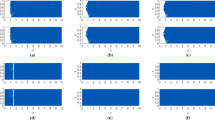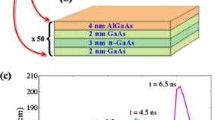Abstract
In this paper, we introduce a novel discrete chaotic map named zigzag map that demonstrates excellent chaotic behaviors and can be utilized in truly random number generators (TRNGs). We comprehensively investigate the map and explore its critical chaotic characteristics and parameters. We further present two circuit implementations for the zigzag map based on the switched current technique as well as the current-mode affine interpolation of the breakpoints. In practice, implementation variations can deteriorate the quality of the output sequence as a result of variation of the chaotic map parameters. In order to quantify the impact of variations on the map performance, we model the variations using a combination of theoretical analysis and Monte-Carlo simulations on the circuits. We demonstrate that even in the presence of the map variations, a TRNG based on the zigzag map passes all of the NIST 800-22 statistical randomness tests using simple post processing of the output data.








Similar content being viewed by others
References
Wiggins, S. (1990). Introduction to applied nonlinear dynamical systems and chaos. Berlin: Springer-Verlag.
Kaneko, K., & Tsuda, I. (2001). Complex systems: Chaos and beyond: A constructive approach with applications in life science. Berlin: Springer.
Nejati, H., Ragheb, T., Hosseini, A., & Massoud, Y. (2007). A programmable input-pulse dependent chaotic oscillator. In Proceedings of IEEE MWSCAS (pp. 173–176).
Nejati, H., Ragheb, T., & Massoud, Y. (2008) On the feasibility of bandwidth tuning in cascaded non-autonomous chaotic oscillators. In Proceedings of IEEE MWSCAS (pp. 902–905).
Menezes, A., Oorschot, P., & Vanstone, S. (1997). Handbook of applied cryptography. Boca Raton, FL : CRC Press Series on Discrete Mathematics and its Applications.
Callegari, S., Rovatti, R., & Setti, G. (2005). Embeddable adc-based true random number generator for cryptographic applications exploiting nonlinear signal processing and chaos. IEEE Transaction on Signal Processing, 53(2), 793–805.
Cover, T. M., & Thomas, J. A. (2006). Elements of information theory. New York: Wiley.
Hu, Y., Liao, X., Wong, K. -W., & Zhou, Q. (2009). A true random number generator based on mouse movement and chaotic cryptography. Chaos, Solitons and Fractals, 40(5), 2286–2293.
Ragheb, T., Laska, J., Nejati, H., Kirolos, S., Baraniuk, R., & Massoud, Y. (2008). A prototype hardware for random demodulation based compressive analog-to-digital conversion. In Proceedings of IEEE MWSCAS (pp. 37–40).
Pfetsch S., Ragheb T., Laska J., Nejati H., Gilbert A., Strauss M., Baraniuk R., & Massoud Y. (2008). On the feasibility of hardware implementation of sub-nyquist random-sampling based analog-to-information conversion. In Proceedings of the IEEE ISCAS (pp. 1480–1483).
Ragheb T., Nejati H., Nieuwoudt A., & Massoud Y. (2006). Parasitic-aware analytical modeling of fully integrated switchable narrow-band cmos low noise amplifiers. In Proceedings of IEEE WAMICON (pp. 1–5).
Nejati, H., Ragheb, T., Nieuwoudt, A., & Massoud, Y. (2007). Analytical modeling methodology for ultra wideband low noise amplifiers with generalized filter-based impedance matching. ALOG, 51(2), 121–127.
Nejati, H., Ragheb, T., Nieuwoudt, A., & Massoud, Y. (2007). Modeling and design of ultrawideband low noise amplifiers with generalized impedance matching networks. In Proceedings of the IEEE ISCAS (pp. 2622–2625).
Nejati, H., Ragheb, T., & Massoud, Y. (2008). On the design of customizable low-voltage common-gate lna-mixer pair using current and charge reusing techniques. In Proceedings of the ACM GLSVLSI (pp. 195–200).
Nejati, H., Ragheb, T., & Massoud, Y. (2008). Analytical modeling of common-gate low noise amplifiers. In Proceedings of the IEEE ISCAS (pp. 888–891).
Nieuwoudt, A., Ragheb, T., Nejati, H., & Massoud, Y. (2009). Numerical design optimization methodology for wideband and multi-band inductively degenerated cascode cmos low noise amplifiers. IEEE Transactions on Circuits and Systems I, 56(6), 1088–1101.
Petrie, C. S., & Connelly, J. A. (2000). A noise-based ic random number generator for applications in cryptography. IEEE Transactions on Circuits and Systems I, 47(5), 615–621.
Jun, B., & Kocher, P. (1999) The intel random number generator. Technical Report Cryptography Research Inc. [online] http://www.cryptography.com/resources/whitepapers.
Evaluation of VIA C3 Nehemiah random number generator. Technical Report Cryptography Research Inc. [online] http://www.cryptography.com/resources/whitepapers. (2003).
Liu, C., & McNeill, J. A. (2005). A digital-PLL-based true random number generator. In IEEE PhD research in microelectronics and electronics (pp. 113–116).
Yalcin, M. E., Suykens, J. A. K., & Vandewalle, J. (2004). True random bit generation from a double-scroll attractor. IEEE Transactions on Circuits and Systems I, 51(7), 1395–1404.
Bean, J., & Langlois P. J. (1994). A current mode analog circuit for tent maps using piecewise linear functions. In IEEE ISCAS (pp. 125–128).
Neumann, J. V. (1951). Various techniques used in connection with random digits. Applied Mathematics Series, 12, 36–38.
SHA-1 Standard, National Institute of Standards and Technology (NIST), Secure Hash Standard. (1995). FIPS PUB 180-1. http://www.itl.nist.gov/fipspubs/fip180-1.htm.
SHA-2 Standard, National Institute of Standards and Technology (NIST), Secure Hash Standard. (2002). FIPS PUB 180-2. http://csrc.nist.gov/publications/fips/fips180-2/fips180-2.pdf.
Beirami, A., & Fekri F. (2011) Results on the redundancy of universal compression for finite-length sequences. In Proceedings of IEEE International Symposium on Information Theory (pp. 1604–1608).
Beirami, A., Sardari, M., & Fekri, F. (2012). Results on the fundamental gain of memory-assisted universal source coding. In Proceedings of IEEE International Symposium on Information Theory (pp. 1092–1096).
Beirami, A., & Fekri, F. (2012). On lossless universal compression of distributed identical sources. In Proceedings of IEEE International Symposium on Information Theory (pp. 566–570).
A statistical test suite for random and pseudorandom number generators for cryptographic applications. Natioanal Institute for Standards and Technology, Special publication 800-22 (2001).
Nejati H., Beirami A., & Massoud Y. (2008). A realizable modified tent map for true random number generation. In Circuits and systems, 2008. MWSCAS 2008. 51st midwest symposium (pp. 621–624).
Li, D., Jin, Y., Shen, H., & Yan, X. (2006). Design of random number generation algorithm. In IEEE ICCIAS (pp. 1287–1290).
Morie, T., Sakabayashi, S., Nagata, M., & Iwata, A. (2000). Cmos circuits generating arbitrary chaos by using pulsewidth modulation techniques. IEEE Transactions on Circuits and Systems I, 47(11), 1652–1657.
Callegari, S., Setti, G., & Langlois, P. J. (1997). A CMOS tailed tent map for the generation of uniformly distributed chaotic sequences. In IEEE ISCAS (pp. 781–784).
Yuan, F. (2007). CMOS current-mode circuits for data communications. New York: Springer.
Wilamowski, B., Ferre-Pikal, E., & Kaynak, O. (2000). Low power, current mode cmos circuits for synthesis of arbitrary nonlinear functions. In 9th NASA symposium on VLSI design (pp. 7.3.1–7.3.8).
Rovatti, R., Manaresi, N., Setti, G., & Franchi, E. (1999). A current-mode circuit implementing chaotic continuous piecewise-affine markov maps. In Proceedings of the seventh international conference on microelectronics for neural, fuzzy and bio-inspired systems (pp. 275–282).
Fiez, T., Liang, G., & Allstot, D. (1991). Switched-current circuit design issues. IEEE Journal on Solid State Circuits, 26(3), 192–202.
International Technology Roadmap for Semiconductors (ITRS). http://public.itrs.net. (2009).
Nassif S. (2001) Modeling and analysis of manufacturing variations. In IEEE CICC (pp. 223–228).
Nieuwoudt, A., Ragheb, T., Nejati, H., & Massoud, Y. (2007). Increasing manufacturing yield for wideband rf cmos lnas in the presence of process variations. In Proceedings of the IEEE ISQED (pp. 801–806).
Nieuwoudt, A., Ragheb, T., Nejati, H., & Massoud, Y. (2009). Variation tolerant design methods for wideband low noise amplifiers. ALOG MSL, 58, 49–54.
Beirami, A., Nejati, H., & Massoud, Y. (2008). A performance metric for discrete-time chaos-based truly random number generators. In Proceedings of IEEE MWSCAS (pp. 37–40).
Zhou, T., Yu, M., & Ye, Y. (2006). A robust high-speed chaos-based truly random number generator for embedded cryptosystems. In IEEE MWSCAS (pp. 536–540).
Wang, Y. -H., Zhang, H. -G., Shen, Z. -D., & Li, K. -S. (2005). Thermal noise random number generator based on SHA-2 (512). In IEEE ICMLC (pp. 3970–3974).
Addabbo, T., Alioto, M., Fort, A., Rocchi, S., & Vignoli, V. (2006). Efficient post-processing module for a chaos-based random bit generator. In IEEE ICECS (pp. 1224–1227).
Sunar, B., Martin, W. J., & Stinson, D. R. (2007). A provably secure true random number generator with built-in tolerance to active attacks. IIEEE Transactions on Computers, 56(1), 109–119.
Gerosa, A., Bernardini, R., & Pietri, S. (2002). A fully integrated chaotic system for the generation of truly random numbers. IEEE Transactions on Circuits and Systems I, 49(7), 993–1000.
Acknowledgments
This work was done in part when the authors were affiliated with Rice University. The authors would like to thank Professor Yehia Massoud for the valuable discussions, comments and suggestions that helped to improve the quality of this paper.
Author information
Authors and Affiliations
Corresponding author
Rights and permissions
About this article
Cite this article
Nejati, H., Beirami, A. & Ali, W.H. Discrete-time chaotic-map truly random number generators: design, implementation, and variability analysis of the zigzag map. Analog Integr Circ Sig Process 73, 363–374 (2012). https://doi.org/10.1007/s10470-012-9893-9
Received:
Accepted:
Published:
Issue Date:
DOI: https://doi.org/10.1007/s10470-012-9893-9




